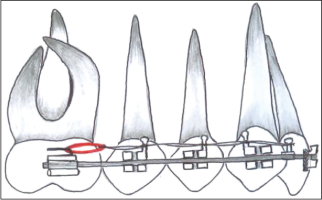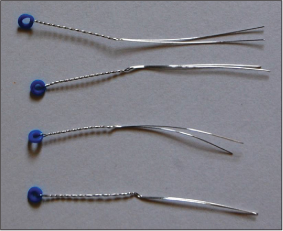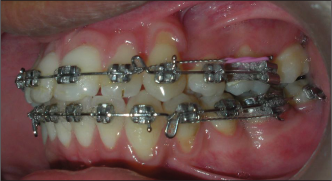Translate this page into:
Improvised tie backs for the preadjusted appliance
Address for Correspondence: Dr. Ameet V. Revankar, Department of Orthodontics and Dentofacial Orthopaedics, S.D.M. College of Dental Sciences, Dharwad, Karnataka, India. E-mail: drameetr@gmail.com
This article was originally published by Wolters Kluwer and was migrated to Scientific Scholar after the change of Publisher.
Abstract
The paper describes modified tiebacks for space closure with the MBT prescription preadjusted appliance. This modification solves the problems associated with the original design.
Keywords
Preadjusted appliance
tie backs
elastomeric module
INTRODUCTION
The use of elastomeric module tiebacks by McLaughlin and Bennett in the Preadjusted appliance ushered in the era of light force techniques for sliding en masse retraction. The technique being simple, effective has stood the test of time. However, the way the elastomeric module is tied to the archwire using a ligature wire as originally described by the authors can introduce certain problems such as:
Hygiene maintenance difficulty
Gingival/soft tissue lacerations from the ligature wire
Hindrance with the premolar brackets having premolded hooks [Figure 1].
 Figure 1
Figure 1- Tie back as originally described by McLaughlin and Bennett
As a solution to these problems, we describe an improvised method of making the tie backs. Using an artery forceps insert a piece of 0.009” stainless steel ligature wire (3M Unitek, Monrovia, CA 91016) through a elastomeric module (3M Unitek, Monrovia, CA 91016) and wind it onto itself to form a smooth coil extending from the elastomeric module to a distance 1.5-2 mm short of the archwire hook [Figure 2] and hence that when the elastomeric module is stretched the wound portion of the ligature wire extends up to the archwire hook [Figure 3].

- Modified tie back winding

- Intraoral picture with modified tiebacks
This article describes improvisation of the Type 1 tie back (distal module).[1] Similar improvisation can be used for the Type B[1] (mesial module) tie back as well. This improvisation overcomes the problems with the traditional method as previously listed.
References
- Systemized Orthodontic Treatment Mechanics. Edinburgh: Mosby; 2001.






